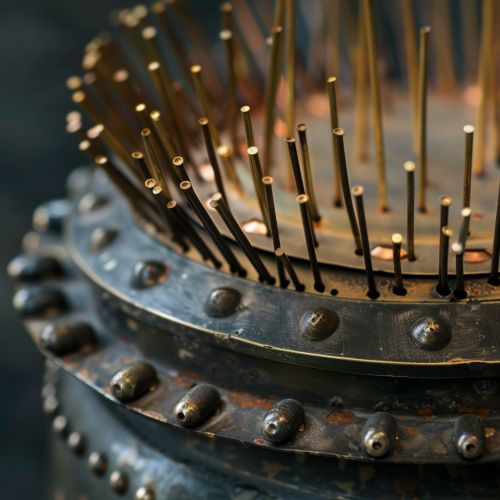Kenzan
Overview
Kenzan is a term of Japanese origin, often used in the context of Ikebana, the traditional Japanese art of flower arrangement. The term "Kenzan" refers to a spiked flower holder, also known as a "spiky frog", used in Ikebana to fix the flowers in the container. The Kenzan is a fundamental tool in Ikebana, allowing for precise placement and positioning of plant materials.


History
The use of Kenzan in Ikebana can be traced back to the Edo period (1603–1868), a time when the art of flower arrangement began to flourish in Japan. The invention of the Kenzan was a significant development in Ikebana, as it allowed for greater creativity and complexity in arrangements. Prior to the use of Kenzan, flowers and plants were simply placed in a vase or container, limiting the potential for artistic expression.
Design and Construction
A Kenzan is typically made of a heavy metal base, often lead, with numerous brass needles protruding from it. The base is designed to sit at the bottom of a vase or container, while the needles hold the stems of flowers or plants in place. The number, length, and arrangement of the needles can vary greatly depending on the specific design of the Kenzan. Some Kenzan are square or rectangular in shape, while others may be round or oval. The size of a Kenzan can also vary, ranging from small, palm-sized pieces to larger, more substantial designs.
Usage in Ikebana
In Ikebana, the Kenzan is used to secure the stems of flowers and plants in the desired position within the container. The stems are inserted onto the needles of the Kenzan, allowing for precise control over the placement and angle of each element in the arrangement. This enables the artist to create a wide range of designs, from simple, minimalist compositions to complex, multi-layered arrangements.
The use of a Kenzan also allows for greater longevity of the arrangement, as the stems are held in place and water can be easily added to the container. This is particularly important in Ikebana, where the beauty and vitality of the arrangement are greatly valued.
Variations and Alternatives
While the traditional Kenzan is a staple tool in Ikebana, there are also variations and alternatives available. For example, some artists may use a Kubari, a natural forked branch, instead of a Kenzan to hold the stems in place. There are also Kenzan that feature adjustable needles, allowing for greater flexibility in the positioning of the stems.
In addition to these variations, there are also modern adaptations of the Kenzan. These include magnetic Kenzan, which use magnets to hold the stems in place, and suction-cup Kenzan, which can be attached to the sides of a container.
